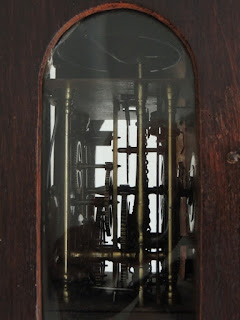This clock is very important to me as it has been hanging on the wall of my grandparents houses my whole life. In fact, it has seen many generations and was bought by Johannes Saris (1873-1959) and then passed down to his eldest child, Hubertina Saris.
This type of clock is called a Friese staartclock, which in English translates to a Frisian tail clock. They were made, conveniently enough, in Friesland, giving us the first part of the name, primarily between around 1770 and 1890. However, they were made in lesser quantities in other provinces of the Netherlands. It seems that small quantities of this style are still made today.
I'm not sure what wood the cabinet is made of, but it seems usually oak and treated with madder to give it a reddish colour.
I remember opa, each morning, pulling the chains to keep the clock going. In the photo above, the clockwork and at the top is the bell. However, I don't think this clock rings out these days.
In this photo, we can see the clockface. At the top is a lovely painted scene, perhaps on the village green looking towards the village. There two people watching a horse drawn carrige being pulled into the village. Around the painted dials of the clockface are four images: top left is Flora, goddess of spring, top right is Ceres as summer, bottom right is Pomona or Bacchus for the autumn, and finally bottom left is Vesta with a fire for winter. For the maker is says W.S.WIERSMA DOCKUM.
On top of the cabinet, Atlas stands in the centre, with the world on his shoulders. To his left and right stand Faam of Fama, a winged mythical figure. I am not sure of the relevance of these figures, but they are common on this type of clock.
My oma (Ida Magermans) received this clock from her parents (Hubertina Saris and Johannes Magermans) as she is the eldest child. Traditionally it should be passed first to my mother (Brigitte Havenith) and then to me. What shall happen? We shall see.





What a beautiful clock! I especially like the clock face with the painting at top and also the green background. One rarely sees such ornate clocks these days. Because you love it, I hope you inherit it.
ReplyDeleteHi Nancy, thank you for your lovely comment. I've always found this clock interesting, but didn't realise how everything on the clock meant something - so that's really added a lot to my appreciation of this clock.
DeleteWhat a treasure! I particularly enjoyed your explanation of the symbolism.
ReplyDeleteThank you.
DeleteHow I love these beautiful clocks... lovely to read the significance of the various parts.
ReplyDeleteThank you.
DeleteWhat a wonderful treasure to have! It's really beautiful and I love that each part has so much meaning. Thanks for sharing!
ReplyDeleteSue
kindredpast.com
That this incredible click has survived intact is amazing. I’m wondering if, like our several old clocks, there is a small lever that shuts off the chime?
ReplyDeleteBeautiful. When we lived in Germany. Every one had a clock and a shrunk. Thanks for sharing that tradition.
ReplyDeleteWhat a beautiful family heirloom! I love the detail in every part of it— especially the clockface. Thanks for sharing!
ReplyDeleteWhat a beautiful and special artifact, Tim! It's amazing that it has survived in such good condition.
ReplyDeleteI also wanted to welcome you to the world of genealogy blogging and invite you to share your post in the August Genealogy Blog Party at My Descendant's Ancestors.